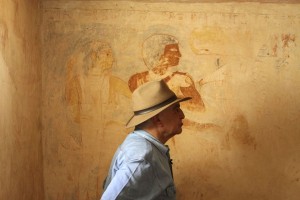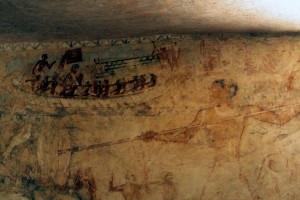Archaeologists excavating near the Giza pyramids uncovered the Fifth Dynasty tomb of a pharaonic priest. It dates to between 2465 and 2323 B.C., and although looters long ago cleared it of its portable treasures, there are wall paintings still in bright condition despite the tomb’s having been opened.
The tomb was found a month ago but Hawass announced the discovery today.
Standing inside the 4,300-year-old structure, Zahi Hawass said hieroglyphics on the tomb’s walls indicate it belonged to Rudj-ka, a priest inspector in the mortuary cult of the pharaoh Khafre, who built the second largest of Giza’s pyramids.
The tomb — about the size of a train car — was adorned with paintings, some of them still vivid. Images on one wall depict a man standing on a boat, spearing fish. Nearby are lotus flowers and different types of birds standing or in flight.
A series of false doors line the opposite wall. A painting above one shows two figures seated opposite each other at an offering table.
The pharaoh Khafre lived from 2558 to 2532 B.C., but his cult continued after death. In the Old Kingdom, after the pharaoh died, priests dedicated to the cult of the king lived and practiced their rituals in a pyramid city specifically dedicated to the task of ensuring proper spiritual care of the departed godking.
Judging from the wall paintings, Rudj-Ka was responsible for overseeing purification rituals performed in honor of the dead pharaoh, which would have made him an important person even though priests of this period did not have to be of noble birth. The tomb’s complexity also suggests a person of prestige. Beyond the entrance, there’s an inner burial complex that carved out of the living rock of a cliff that was built to house all of Rudj-Ka’s family.
His tomb was the first one found west of Khafre’s pyramid, and the only one in the area with a cartouche of Khafre. Hawass hopes there are more tombs, possibly from the priestly cult of Khafre, to be found in this relatively unexplored area.

